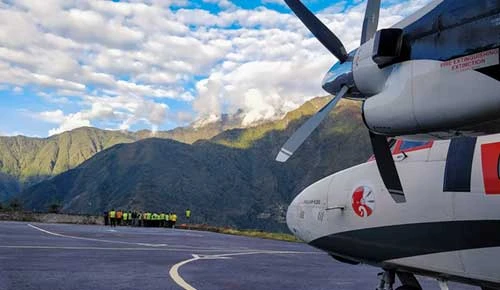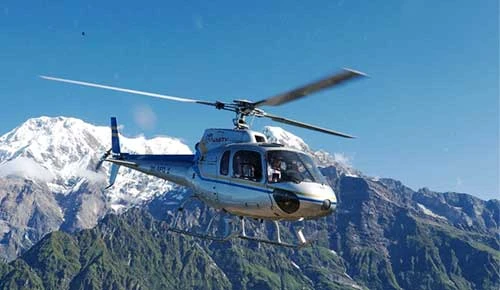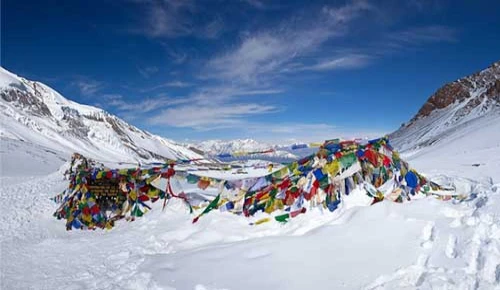A Complete Guide About Drone Rules in Nepal
Nepal has always been a dream destination for travelers, with its towering mountains, lush jungles, and stunning valleys. This natural beauty attracts adventurers and photographers from around the globe every year.
Just like trekking, photography has also been evolving in Nepal, and drone photography is becoming increasingly popular. People are using drones to capture Nepal's breathtaking landscapes from unique perspectives. With its diverse terrain, Nepal offers endless opportunities for stunning drone photos. From high-altitude lakes to dense forests and alpine meadows, Nepal has it all.
Imagine capturing the majestic Himalayas from above, with snow-capped peaks and colorful rhododendron blooms in the Annapurna region & Sunrise view from Kalapatthar in Everest base camp. It's a photographer's paradise!
But before you take your drone out for a spin in Nepal, you might wonder: Is it legal? The answer is yes, but there are rules you need to follow.
In this post, we'll discuss Nepal's drone laws. You'll learn where you can fly your drone, how to get permission, and what to do to ensure a smooth flying experience without breaking any rules. So, let's dive in and get ready to capture Nepal's beauty from the sky!
Table of Contents
Regulations and Compliance Guidelines for Operating Drones in Nepal's Open Category
In Nepal, the regulations regarding the registration and operation of civil unmanned aircraft systems (UAS), commonly known as drones, are outlined in Part 101 of the Civil Aviation Regulations. Part 101 covers various aspects of drone operations, including registration, certification, and operation categories.
The provisions of Part 101 apply to two main categories:
Registration and operation of civil unmanned aircraft systems
This encompasses all drones used for civil purposes within Nepal's airspace. It includes requirements related to registration of the drones, certification of remote pilots, and adherence to operational standards set forth by the Civil Aviation Authority of Nepal (CAAN).
Operations in the open category
This category specifically pertains to drones with a Maximum Takeoff Weight (MTOW) of 25 kg or less. Throughout the entire operation under this category, the drone must maintain a MTOW of 25 kg or less, including all items onboard or attached to the aircraft. Operations under the open category must comply with the regulations outlined in Part 101.007 of the Civil Aviation Regulations.
Let's delve deeper into the provisions outlined in Part 101.007, which pertains to "Inspection, Testing, and Demonstration of Compliance":
Remote pilot's responsibility
Upon request by the Civil Aviation Authority of Nepal (CAAN), the remote pilot or person manipulating the flight controls of a drone must provide certain documents, including:
Remote pilot certificate: This document certifies that the individual is authorized to operate the drone.
Any other document, record, or report required to be kept under Part 101: This may include maintenance records, flight logs, or other relevant documentation.
Inspections and tests by CAAN
The CAAN has the authority to conduct tests or inspections of the following entities to ensure compliance with Part 101:
- Unmanned aircraft system (UAS): This includes the drone itself, its components, and any associated equipment.
- Remote pilot: The individual responsible for operating the drone.
- Person manipulating the flight controls of a drone: This refers to individuals who may be controlling the drone during flight.
- UA observer (if applicable): Individuals tasked with observing the drone's operation.
Drone Registration: Securing Your Unique Identification Number (UIN)
In Nepal, registering your drone with the Civil Aviation Authority of Nepal (CAAN) is mandatory before you can fly it legally. This process assigns a unique identifier number (UIN) to your drone, making it traceable and ensuring responsible operation.
Here's a breakdown of the registration process:
Eligibility: All drones, regardless of weight, require registration with CAAN.
Documents Required: The exact list of documents may vary, so it's best to check the latest requirements on the CAAN website (https://caanepal.gov.np/drone). However, some general documents you might need include:
- Completed application form (available on CAAN website)
- Proof of ownership (purchase receipt, invoice)
- Drone model and serial number information
- Photos of your drone (showing all sides)
- Proof of insurance (for heavier drones)
Physical Verification (for heavier drones): Drones exceeding 2kg might require a physical inspection at CAAN's office for verification purposes.
Application Submission: You can submit the application package in person at the CAAN Flight Safety Standards Department (FSSD) in Kathmandu or follow any online submission procedures they may offer.
Processing Time: The application processing typically takes 2-3 working days, upon which you'll receive a registration certificate with your unique identification number (UIN).
Note: This UIN needs to be displayed on your drone during operation for easy identification by authorities.
Category of Drone in Nepal
the drone categorization based on Maximum Take-off Weight (MTOW), presented in a table format:
Category | Description | Maximum Take-off Weight (MTOW) |
A | "Very Low Risk" Operations | Less than 250 grams |
B | "Low Risk" Operations | 250 grams to 2 kilograms |
C | "Regulated Low Risk" Operations | 2 kilograms to 25 kilograms |
D | "Regulated High Risk" Operations | Above 25 kilograms |
Category A: "Very Low Risk" Operations:
These operations involve drones with an extremely low weight, less than 250 grams. Drones in this category are considered to pose minimal risk to the airspace and surrounding environment. They typically include small, lightweight drones used for recreational purposes or basic aerial photography.
Category B: "Low Risk" Operations
Operations in this category involve drones with a weight ranging from 250 grams to 2 kilograms. While still relatively low risk, these drones may be slightly larger and capable of carrying heavier payloads. They are often used for hobbyist activities, aerial photography, or small-scale commercial applications.
Category C: "Regulated Low Risk" Operations
Drones categorized under Category C have a weight between 2 kilograms and 25 kilograms. These operations are considered low risk but are subject to regulation and oversight by the aviation authorities. Drones in this category are commonly used for various commercial purposes, including surveying, mapping, agriculture, and infrastructure inspections.
Category D: "Regulated High Risk" Operations
This category encompasses drones with a weight exceeding 25 kilograms. Operations involving such drones are classified as high risk due to their larger size and potential for greater impact in the event of accidents or malfunctions. Category D operations are subject to stringent regulations and safety requirements. These drones are typically used for specialized applications such as heavy cargo transport, industrial inspections, or emergency response missions.
By categorizing drones based on their maximum take-off weight (MTOW), authorities can establish appropriate regulatory frameworks and safety measures tailored to the specific risks associated with different types of drone operations.
Guidelines for Operating Drones in Nepal
Before flying your drone in Nepal, it's essential to know the regulations set forth by the authorities. These guidelines ensure the safety of airspace and individuals on the ground while also respecting privacy and avoiding disruption to public gatherings and infrastructure.
Here's a list of the key rules for flying drones in Nepal:
- Drones weighing over 2 kilograms and flying at altitudes of 400 feet or more require prior authorization from the Department of Tourism, Ministry of Home Affairs, and the CAAN (Civil Aviation Authority of Nepal).
- Drones must not exceed an altitude of 120 meters (394 feet) above ground level.
- Keep drones within a maximum distance of 500 meters (1,640 feet) from the operator.
- Drones are not permitted to drop articles or animals.
- Do not fly drones over or within 150 meters (492 feet) of congested areas or organized open-air assemblies with more than 1,000 people.
- Maintain a distance of at least 50 meters (164 feet) from vessels, vehicles, or structures.
- Operators must maintain unaided visual sight with their drones at all times during flight.
- Drone activity is strictly prohibited within airport areas to ensure the safety of manned aviation.
Following these rules encourages responsible drone usage and safeguards both drone lovers and those living in Nepal.
Regestration and Permit for Drone Flying in Nepal
In Nepal, drones must be registered with the Civil Aviation Authority (CAAN) to ensure their legal operation. Once registered, each drone is issued a unique identification number, providing a means for authorities to monitor and regulate their activities.
Operating drones in national parks are likewise restricted by rules that require permit from the park's management. Drone operation permits are issued for a period of three months, following which renewal is necessary to ensure ongoing conformity to legal regulations.
These steps are meant to encourage safe and responsible drone use while also making sure that people follow the rules set by the government.
Required Documents for Temporary License:
- Passport with valid visa
- Letter of commitment from the applicant to comply with the existing UAV requirements of the Civil Aviation Authority of Nepal (CAAN) and Ministry of Home Affairs (MOHA) UAV working procedure 2019, including flight information (purpose, location, and duration of operation)
- Any additional documents regarding drone operation
Note: Drones should have CE marking.
Laws for Flying Drone in Nepal
- Visitors must obtain permission from the Department of Tourism, the Ministry of Home Affairs, and the Civil Aviation Authority of Nepal before flying a drone, unless the drone weighs less than two kilograms and flies less than 200 feet above the ground.
- Drones weighing over 2 kilograms and flying at altitudes of 400 feet or more require prior authorization from the Department of Tourism, Ministry of Home Affairs, and the Civil Aviation Authority of Nepal (CAAN).
- For research and instructional use of drones weighing more than 2kg, prior licenses from relevant authorities are necessary.
- Permission is needed to operate drones within national parks and conservation areas.
- When flying over private property and at a height of no more than 200 feet, drones weighing less than 2 kg are excused from CAAN authorization.
- Drone operators must possess piloting expertise and a rudimentary knowledge of Nepali drone operating regulations and legislation.
- Avoid jeopardizing nearby aircraft security.
- Flying without a permit is illegal and punishable.
- Permission is required from local security organizations for recreational drone use in public areas.
- Any harm the drone may cause is the operator's fault.
- Keep drones within a maximum distance of 500 meters (1,640 feet) from the operator.
- Drones are not permitted to drop articles or animals.
- Avoid flying drones over or within 150 meters (492 feet) of congested areas or organized open-air assemblies with more than 1,000 people.
- Maintain a distance of at least 50 meters (164 feet) from vessels, vehicles, or structures.
- Drone activity should be eliminated from airport zones.
- Visual line of sight with the drone must be maintained at all times during flight.
- Prohibited drone activity within airport areas to ensure the safety of manned aviation.
Additional Regulations for Foreign Drone Users in Nepal
For foreign visitors traveling with drones in Nepal, there aren't any extra rules set by the government. But in certain places, especially where large and advanced drones are involved, strict regulations apply. You'll need a license to operate such drones, along with a list of documents to submit to the authorities. CAAN has made a useful handbook with detailed information about Nepal's drone laws.
Moreover, international travelers need authorization letters from several authorities and documents:
- A letter from the General Administration, Home Ministry, Tourism Ministry, Foreign Affairs Ministry, Defense Ministry, and Federal Affairs Ministry.
- A letter from the tour operator and travel agency handling your trip arrangements.
- A commitment letter from the drone pilot promising to follow all drone laws and guidelines.
Similarly, if you're a foreign visitor planning to trek in Nepal, especially in regions like Everest, Annapurna, Langtang, or Manaslu, you need authorization from the Department of National Park and Wildlife Conservation to fly your drone during the trek.
Restricted Areas for Drone Operations in Nepal
The new drone operation regulations in Nepal have identified specific regions as restricted areas for drone activities. These areas include:
- All drone activity is prohibited within a 5-kilometer radius of the airport.
- Drones cannot be operated within a 5-kilometer horizontal distance from the international boundary.
- Drones are restricted within a 1-kilometer radius of religious, heritage, and sacred sites.
- Drone operations are not allowed within a 1 km aerial radius of Presidential, Vice-Presidential, Prime Ministerial, and VVIP Offices and residences.
- Drone activity is restricted within a 1-kilometer radius of military and safety offices, and within 500 meters of other safety departments.
- Drone operations are prohibited in areas with conflicts or wars.
- Additional restriction areas may be designated by provincial or local governments
Consequences of Violating Drone Regulations in Nepal
Breaking any of the drone regulations in Nepal can lead to severe penalties, including fines, imprisonment, or both. According to the law, fines range from NPR 2000 to NPR 5000, depending on the seriousness of the violation and any resulting loss or damage. The purpose of flying the drone, whether for business or leisure, also affects the penalty. Additionally, authorities may confiscate your drone in certain circumstances. As a result, the fines and penalties can vary based on the nature of the violation and your intentions while flying the drone.
Exploring Drone Rules in Nepal: A Friendly Guide
In wrapping up, it's essential to grasp and follow Nepal's drone rules, whether you're a local or a visitor. These rules keep the skies safe, safeguard privacy, and prevent accidents.
By getting the right permits, sticking to height and distance limits, and respecting local laws, you can enjoy flying your drone responsibly amidst Nepal's stunning scenery. Remember, breaking these rules can lead to serious consequences, like fines or losing your drone.
So, let's enjoy Nepal's beauty while also following its rules for a safe and fun experience. If you need any assistance or have questions, feel free to reach out to us at anytime via email or WhatsApp. We're here to help!








